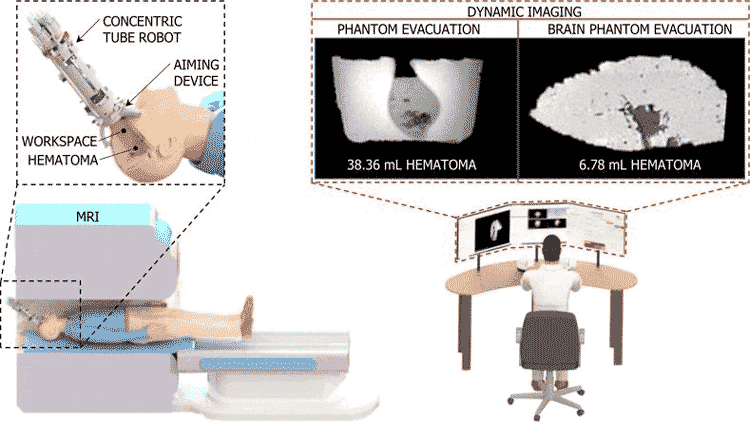The World Health Organization (WHO) reported stroke as the cause of over six million deaths in 2019. Intracerebral hemorrhage (ICH), the deadliest stroke sub-type, is the hemorrhaging of blood due to ruptured blood vessels within the brain. Although the aggressive nature of ICH results in 40% of deaths within two days of symptom onset, “watchful waiting” has been a common treatment approach due to the potential damage from open craniotomy evacuation. Recently, minimally invasive surgery (MIS) has proven to be a safer alternative to open craniotomies; however, MIS is limited by (i) inadequate visualization of the hematoma during evacuation, and (ii) the limited dexterity of conventional neuroendoscopes that cause collateral damage to the surgical corridor during device manipulation.
In this paper, we propose the design and evaluation of ASPIHRE, a skull mounted MR-conditional ICH evacuation concentric tube robot (CTR) made entirely of non-metallic materials. This CTR is the first to use off-the-shelf plastic tubes, which improves visualization during dynamic 1-Hz MR imaging. A kinematic model is developed based on a discretized piece-wise constant curvature approach, and a tube mechanics model is used to compensate torsional deflection of the inner tube. In this paper, an MR-safe pneumatic motor is used to control the CTR via a custom-designed variable gain PID algorithm. Finally, the targeting accuracy and the evacuation efficacy of the CTR were evaluated in systematic bench-top and MRI experiments.
The pneumatic motor with the proposed control algorithm was able to achieve a rotational accuracy of 0.32°±0.30°. The kinematic model enabled a positional accuracy of the CTR tip of 1.39±0.54 mm. The robot was able to evacuate an initial 38.36 mL clot, leaving a residual hematoma of 8.14 mL after 5 minutes, well below the 15 mL guideline suggesting good post-ICH evacuation clinical outcomes.

